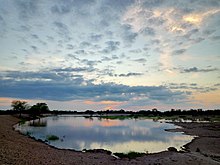This article includes a list of general references, but it lacks sufficient corresponding inline citations. (April 2015) |


A johad, also known as a pokhar or a percolation pond, is a community-owned traditional harvested rainwater storage wetland principally used for effectively harnessing water resources in the states of Haryana, Rajasthan, Punjab, and western Uttar Pradesh of North India, that collects and stores water throughout the year, to be used for the purpose of recharging the groundwater in the nearby water wells, washing, bathing and drinking by humans and cattle.[1][2][3][4] Some johads also have bricked or stones masonry and cemented ghat (series of steps and/or ramp).[1][2][4]
Rainwater fills the pit. These are connected to other small pits like this. The extra rainwater is filled in the smaller pits. They are then used for cleaning, drinking and washing purposes.
Johads also cater to resident and seasonal migrant birds as well as wildlife animals from the nearby bani (forest). State fisheries departments also promote the use of these johads for raising fishes on contract basis for commercial fishing. Johads are often seen surrounded by embankment, with water well and trees around them. In many parts, specially in dry state of Rajasthan, the annual rainfall is very low (between 450 and 600 mm) and the water can be unpleasant to drink. Rainfall during July and August is stored in johads and used throughout the year. Johad in Haryanvi language and Rajasthani language are also called sarovar, taal and talab in Hindi language, and water pond or lake in English. A similar structure to a johads, called a khadin, consists of a very low and long earthen bund in the Jaisalmer district. Over 4,500 working johads in Alwar district and surrounding districts Rajasthan were revived by the NGO Tarun Bharat Sangh by Rajendra Singh. Haryana formed the Haryana State Waterbody Management Board to rejuvenate and manage 14,000 ponds in the state, including the development of 60 lakes in Delhi NCR falling within the state.[5][6]
Smaller cemented water tanks called taankas in parts of Rajasthan are also sometimes mistakenly referred to as johads. Concretized rain-fed taanka and canal-fed diggi are different from the johads.
- ^ a b Haruka Yanagisawa, 2015, Community, Commons and Natural Resource Management in Asia:
- ^ a b Video: How India's 'Water Man' first revived a river and a village in Rajasthan, Scroll.in, 23 Mar 2015.
- ^ Amanda Suutari and Gerry Marten, Water Warriors: Rainwater Harvesting to Replenish Underground Water (Rajasthan, India), Jun 2015.
- ^ a b Margaret Robertson, 2007, Sustainable Futures: Teaching and Learning: a Case Study Approach.
- ^ Cite error: The named reference
HarWater1was invoked but never defined (see the help page). - ^ Cite error: The named reference
HarWater2was invoked but never defined (see the help page).